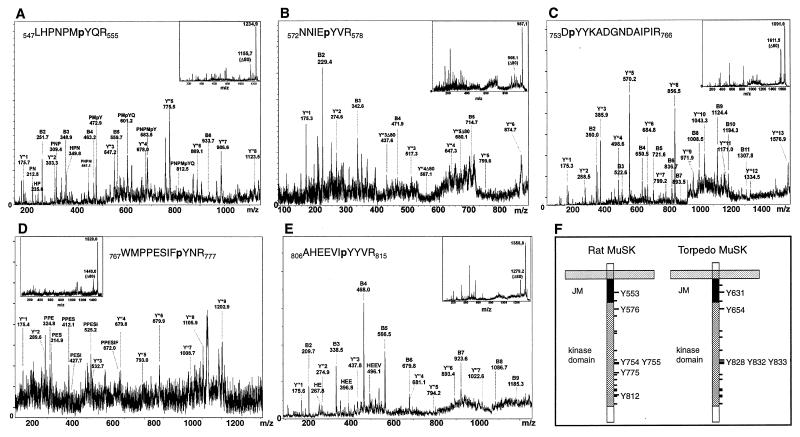Figure 2.
Fragment ion spectra of phosphopeptides derived from in vitro phosphorylated MuSK. The parent ion masses but not the masses of the fragment ions are slightly shifted in some of the PSD spectra. The fragment ions derived from the peptide N-termini (B-ions) and from the C-termini (Y"-ions) are indicated. In some cases, internal fragment ion series derived from proline-directed decay (resulting in a new B-ion series starting from proline) were more prominent than the B-ion series. The inserts show the entire PSD spectra. The regions of the spectra containing the fragment ions are enlarged and annotated. (A) pY553. The entire Y"-ion series is apparent in the PSD spectrum, consistent with Y553 as the phosphoamino acid within this peptide. This is further supported by internal fragment ion series starting from P549 and P551. (B) pY576. A partial B-ion series and a Y"-ion series. Y"3 containing Y576 is present in the phosphorylated state, indicating that Y576 is the phosphoamino acid within this peptide. Peaks that are not present in a classic ion series are unassigned and most likely arise from cleavage of nonpeptide bonds; their presence does not complicate our ability to assign ions present in a classic series to a particular sequence in MuSK. (C) pY754. A prominent B-ion series extending to I764. The B2-ion of 360.0 Da indicates that Y754 is the phosphoamino acid within this peptide. This is supported by the presence of the Y"12-ion containing Y755 in the nonphosphorylated state. (D) pY775. Although not all fragment ion signals can be unambiguously interpreted, the Y"-ion series is reliably detected. The peptide sequence is further confirmed by the presence of a partial internal fragment ion series starting from P769. The presence of the Y"-ion series in the phosphorylated state starting from the Y"3-ion indicates that Y775 is the phosphoamino acid within this peptide. (E) pY812. The PSD spectrum is dominated by a strong B-ion series. The B7-ion shows up in the phosphorylated state, indicating that Y812 is the phosphoamino acid within this peptide. (F) The cartoon illustrates the transmembrane and cytoplasmic domains of rat and Torpedo MuSK. The locations of all tyrosine residues are indicated by dashes, and the positions of phosphorylated tyrosine residues are numbered.

